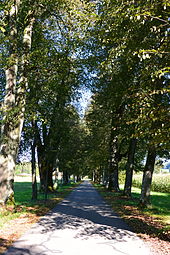Rosegg Castle
Rosegg Castle , also known as Lucretia Castle or Liechtenstein Castle , is a castle built from 1772 in the valley floor north of the castle hill of Rosegg in Carinthia , halfway between St. Michael and Duel.
history
The lordship, based at Rosegg Castle , had been owned by the Orsini-Rosenberg family since 1686 . In September 1772, Count Franz Xaver Wolfgang von Orsini-Rosenberg , Chamberlain and Conference Minister and a close confidante of Maria Theresa and her son Joseph II , began building a “residential and castle building” not far from the castle, which used the medieval castle as the mansion should replace. The two-storey structure with two lower farm wings was completed before 1780. It was built for his Italian lover, Madame Lucrezia.
After its construction, the castle replaced Rosegg Castle as the seat of the Rosegg rulership. In 1829 the Orsini-Rosenberg family left their Rosegger possessions to Peter Ritter von Bohr , who from 1830 had a zoo built around the castle, which was badly damaged during the French wars at the beginning of the 19th century. As early as 1833 Rosegg changed hands again and passed to the House of Liechtenstein , which still owns it today.
The outside of the building has hardly been changed since it was built, the interior probably only in the second half of the 19th century. The interiors were renovated in 1996/97, revealing late baroque and classicist room settings with stucco ceilings and wall paintings (floral wallpaper patterns).
Building description
lock
The complex of Rosegg Castle consists of the two-storey main building, designed in the classical style, and the two former farm buildings, which are laterally connected to the main wing.
The main building is reminiscent of the Italian Brenta villas around Padua, where Prince Orsini-Rosenberg had spent a few years. Similar buildings in Tuscany , where the client had maintained close contacts, or in the Terraferma near Venice, where his second wife Justinia Wynne wrote a richly illustrated book about a villa , could have served as models for the castle . It has a shallow central and corner projections and is decorated with a cornice .
Gardens
There is a small baroque garden by the castle, and on the former river island - now a loop of the river - the Drava was an extensive landscape garden. The original gardens were destroyed in a flood in 1825 .
The entire main axis of the complex connects Alt-Rossegg and Neu-Rossegg to the north and continues with the transverse axis in the form of a slightly bent cross towards the Drau and the town. In front of the castle there is a small French-style border area, with a corresponding forest area in the back. There are two Roman grave inscriptions in the garden wall of the castle. Against the Drava and on the transverse axis there are mighty avenues of lime trees, some of them from the time of construction. 90% winter linden (Tilia cordata), the rest summer linden (Tilia platyphyllos).
A maze was created in 2001 on the axis to the south . It is the largest garden labyrinth in Austria, with one kilometer of hedge made up of 3,000 hornbeams .
The former castle hill was the walled zoo of the castle, laid out around 1830 by Ritter von Bohr. Today it is operated as the Wildlife Park Tierpark Rosegg . In addition to the Alt-Rosegg ruins, there is also a Gothic farm building for Rosegg Castle and the former nursing home (hunter's house) . The rest of the area in the Drauschlinge is used for agriculture today.
The castle park is one of the most important garden architectural monuments in Austria and is mentioned in the Monument Protection Act ( No. 6 in the appendix to Section 1, Paragraph 12 of the DMSG ). The avenues are a natural monument ( NDM VL 08 Linden-Alleen in Rosegg , 2.4 ha).
literature
- Dehio Handbook Carinthia. Schroll, Vienna 2001, ISBN 3-7031-0712-X , p. 689.
- Wilhelm Deuer: Castles and palaces in Carinthia. Heyn, Klagenfurt 2008, ISBN 978-3-7084-0307-6 , pp. 30-32.
Web links
- Entry via Rosegg - Castle on Burgen-Austria
- Rosegg Castle and Zoo
Individual evidence
- ↑ a b Deuer 2008, p. 31.
- ↑ a b castle. ( Memento from January 24, 2016 in the Internet Archive ) rosegg.at, accessed November 20, 2015.
- ↑ Dehio 2001, p. 689.
- ^ Eva Berger: Historical Gardens of Austria: Gardens and parks from the Renaissance to around 1930 . tape 2 Upper Austria, Salzburg, Vorarlberg, Carinthia, Styria, Tyrol . Böhlau, Vienna 2003, ISBN 978-3-205-99352-0 , Rosegg, Schlosspark , p. 393 f . ( limited preview in Google Book search).
- ↑ a b labyrinth. ( Memento of September 28, 2015 in the Internet Archive ) rosegg.at, accessed November 20, 2015.
- ↑ a b Linden avenues at Rosegg Castle. ( Memento from March 5, 2016 in the Internet Archive ) Schutzgebiete.ktn.gv.at → Natural monument .
Coordinates: 46 ° 35 '28.1 " N , 14 ° 1' 27.7" E


